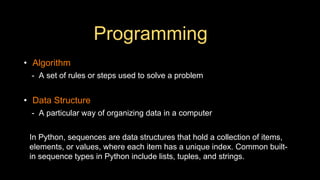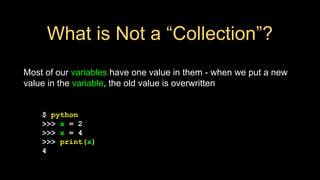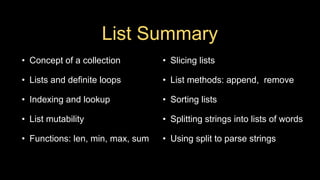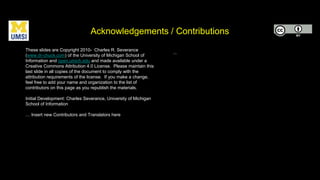The document provides an overview of Python lists as a data structure, emphasizing their mutability and ability to store multiple values in a single variable. It covers key concepts such as list creation, indexing, concatenation, slicing, and methods like append and sort, while also introducing functions related to lists. Additionally, it discusses the use of the split method to convert strings into lists of words, reinforcing the interactions between lists and strings in Python.



![A List is a Kind of
Collection
• A collection allows us to put many values in a single “variable”
• A collection is nice because we can carry all many values
around in one convenient package.
friends = [ 'Joseph', 'Glenn', 'Sally' ]
carryon = [ 'socks', 'shirt', 'perfume' ]](https://image.slidesharecdn.com/pythonlearn-08-lists-240508194408-e13ef217/85/Pythonlearn-08-Lists-for-fundatmentals-of-Programming-4-320.jpg)
![List Constants
• List constants are surrounded by
square brackets and the elements
in the list are separated by
commas
• A list element can be any Python
object - even another list
• A list can be empty
>>> print([1, 24, 76])
[1, 24, 76]
>>> print(['red', 'yellow',
'blue'])
['red', 'yellow', 'blue']
>>> print(['red', 24, 98.6])
['red', 24, 98.6]
>>> print([ 1, [5, 6], 7])
[1, [5, 6], 7]
>>> print([])
[]](https://image.slidesharecdn.com/pythonlearn-08-lists-240508194408-e13ef217/85/Pythonlearn-08-Lists-for-fundatmentals-of-Programming-5-320.jpg)
![We Already Use Lists!
for i in [5, 4, 3, 2, 1] :
print(i)
print('Blastoff!')
5
4
3
2
1
Blastoff!](https://image.slidesharecdn.com/pythonlearn-08-lists-240508194408-e13ef217/85/Pythonlearn-08-Lists-for-fundatmentals-of-Programming-6-320.jpg)
![Lists and Definite Loops - Best Pals
friends = ['Joseph', 'Glenn', 'Sally']
for friend in friends :
print('Happy New Year:', friend)
print('Done!')
Happy New Year: Joseph
Happy New Year: Glenn
Happy New Year: Sally
Done!
z = ['Joseph', 'Glenn', 'Sally']
for x in z:
print('Happy New Year:', x)
print('Done!')](https://image.slidesharecdn.com/pythonlearn-08-lists-240508194408-e13ef217/85/Pythonlearn-08-Lists-for-fundatmentals-of-Programming-7-320.jpg)
![Looking Inside Lists
Just like strings, we can get at any single element in a list using an
index specified in square brackets
0
Joseph
>>> friends = [ 'Joseph', 'Glenn', 'Sally' ]
>>> print(friends[1])
Glenn
>>>
1
Glenn
2
Sally](https://image.slidesharecdn.com/pythonlearn-08-lists-240508194408-e13ef217/85/Pythonlearn-08-Lists-for-fundatmentals-of-Programming-8-320.jpg)
![Lists are Mutable
• Strings are “immutable” - we
cannot change the contents of a
string - we must make a new string
to make any change
• Lists are “mutable” - we can
change an element of a list using
the index operator
>>> fruit = 'Banana'
>>> fruit[0] = 'b'
Traceback
TypeError: 'str' object does not
support item assignment
>>> x = fruit.lower()
>>> print(x)
banana
>>> lotto = [2, 14, 26, 41, 63]
>>> print(lotto)
[2, 14, 26, 41, 63]
>>> lotto[2] = 28
>>> print(lotto)
[2, 14, 28, 41, 63]](https://image.slidesharecdn.com/pythonlearn-08-lists-240508194408-e13ef217/85/Pythonlearn-08-Lists-for-fundatmentals-of-Programming-9-320.jpg)
![How Long is a List?
• The len() function takes a list as a
parameter and returns the number
of elements in the list
• Actually len() tells us the number of
elements of any set or sequence
(such as a string...)
>>> greet = 'Hello Bob'
>>> print(len(greet))
9
>>> x = [ 1, 2, 'joe', 99]
>>> print(len(x))
4
>>>](https://image.slidesharecdn.com/pythonlearn-08-lists-240508194408-e13ef217/85/Pythonlearn-08-Lists-for-fundatmentals-of-Programming-10-320.jpg)
![Using the range Function
• The range function returns
a list of numbers that range
from zero to one less than
the parameter
• We can construct an index
loop using for and an
integer iterator
>>> print(range(4))
[0, 1, 2, 3]
>>> friends = ['Joseph', 'Glenn', 'Sally']
>>> print(len(friends))
3
>>> print(list(range(len(friends))))
[0, 1, 2]
>>>](https://image.slidesharecdn.com/pythonlearn-08-lists-240508194408-e13ef217/85/Pythonlearn-08-Lists-for-fundatmentals-of-Programming-11-320.jpg)
![A Tale of Two Loops...
friends = ['Joseph', 'Glenn', 'Sally']
for friend in friends :
print('Happy New Year:', friend)
for i in range(len(friends)) :
friend = friends[i]
print('Happy New Year:', friend) Happy New Year: Joseph
Happy New Year: Glenn
Happy New Year: Sally
>>> friends = ['Joseph', 'Glenn', 'Sally']
>>> print(len(friends))
3
>>> print(list(range(len(friends))))
[0, 1, 2]
>>>](https://image.slidesharecdn.com/pythonlearn-08-lists-240508194408-e13ef217/85/Pythonlearn-08-Lists-for-fundatmentals-of-Programming-12-320.jpg)
![Concatenating Lists Using +
We can create a new list
by adding two existing
lists together
>>> a = [1, 2, 3]
>>> b = [4, 5, 6]
>>> c = a + b
>>> print(c)
[1, 2, 3, 4, 5, 6]
>>> print(a)
[1, 2, 3]](https://image.slidesharecdn.com/pythonlearn-08-lists-240508194408-e13ef217/85/Pythonlearn-08-Lists-for-fundatmentals-of-Programming-13-320.jpg)
![Lists Can Be Sliced Using :
>>> t = [9, 41, 12, 3, 74, 15]
>>> t[1:3]
[41,12]
>>> t[:4]
[9, 41, 12, 3]
>>> t[3:]
[3, 74, 15]
>>> t[:]
[9, 41, 12, 3, 74, 15]
Remember: Just like in
strings, the second
number is “up to but not
including”](https://image.slidesharecdn.com/pythonlearn-08-lists-240508194408-e13ef217/85/Pythonlearn-08-Lists-for-fundatmentals-of-Programming-14-320.jpg)
![List Methods
>>> x = list()
>>> type(x)
<type 'list'>
>>> dir(x)
[... 'append', 'count', 'extend', 'index', 'insert',
'pop', 'remove', 'reverse', 'sort']
>>>
http://docs.python.org/tutorial/datastructures.html](https://image.slidesharecdn.com/pythonlearn-08-lists-240508194408-e13ef217/85/Pythonlearn-08-Lists-for-fundatmentals-of-Programming-15-320.jpg)
![Building a List from Scratch
• We can create an empty list
and then add elements using
the append method
• The list stays in order and
new elements are added at
the end of the list
>>> stuff = list()
>>> stuff.append('book')
>>> stuff.append(99)
>>> print(stuff)
['book', 99]
>>> stuff.append('cookie')
>>> print(stuff)
['book', 99, 'cookie']](https://image.slidesharecdn.com/pythonlearn-08-lists-240508194408-e13ef217/85/Pythonlearn-08-Lists-for-fundatmentals-of-Programming-16-320.jpg)
![Is Something in a List?
• Python provides two operators
that let you check if an item is
in a list
• These are logical operators
that return True or False
• They do not modify the list
>>> some = [1, 9, 21, 10, 16]
>>> 9 in some
True
>>> 15 in some
False
>>> 20 not in some
True
>>>](https://image.slidesharecdn.com/pythonlearn-08-lists-240508194408-e13ef217/85/Pythonlearn-08-Lists-for-fundatmentals-of-Programming-17-320.jpg)
![Lists are in Order
• A list can hold many
items and keeps
those items in the
order until we do
something to change
the order
• A list can be sorted
(i.e., change its order)
• The sort method
(unlike in strings)
means “sort yourself”
>>> friends = [ 'Joseph', 'Glenn', 'Sally' ]
>>> friends.sort()
>>> print(friends)
['Glenn', 'Joseph', 'Sally']
>>> print(friends[1])
Joseph
>>>](https://image.slidesharecdn.com/pythonlearn-08-lists-240508194408-e13ef217/85/Pythonlearn-08-Lists-for-fundatmentals-of-Programming-18-320.jpg)
![Built-in Functions and Lists
• There are a number of
functions built into Python
that take lists as
parameters
• Remember the loops we
built? These are much
simpler.
>>> nums = [3, 41, 12, 9, 74, 15]
>>> print(len(nums))
6
>>> print(max(nums))
74
>>> print(min(nums))
3
>>> print(sum(nums))
154
>>> print(sum(nums)/len(nums))
25.6](https://image.slidesharecdn.com/pythonlearn-08-lists-240508194408-e13ef217/85/Pythonlearn-08-Lists-for-fundatmentals-of-Programming-19-320.jpg)

![Best Friends: Strings and Lists
>>> abc = 'With three words'
>>> stuff = abc.split()
>>> print(stuff)
['With', 'three', 'words']
>>> print(len(stuff))
3
>>> print(stuff[0])
With
>>> print(stuff)
['With', 'three', 'words']
>>> for w in stuff :
... print(w)
...
With
Three
Words
>>>
Split breaks a string into parts and produces a list of strings. We think of these
as words. We can access a particular word or loop through all the words.](https://image.slidesharecdn.com/pythonlearn-08-lists-240508194408-e13ef217/85/Pythonlearn-08-Lists-for-fundatmentals-of-Programming-21-320.jpg)
![>>> line = 'A lot of spaces'
>>> etc = line.split()
>>> print(etc)
['A', 'lot', 'of', 'spaces']
>>>
>>> line = 'first;second;third'
>>> thing = line.split()
>>> print(thing)
['first;second;third']
>>> print(len(thing))
1
>>> thing = line.split(';')
>>> print(thing)
['first', 'second', 'third']
>>> print(len(thing))
3
>>>
● When you do not specify a
delimiter, multiple spaces are
treated like one delimiter
● You can specify what delimiter
character to use in the splitting](https://image.slidesharecdn.com/pythonlearn-08-lists-240508194408-e13ef217/85/Pythonlearn-08-Lists-for-fundatmentals-of-Programming-22-320.jpg)
![fhand = open('mbox-short.txt')
for line in fhand:
line = line.rstrip()
if not line.startswith('From ') : continue
words = line.split()
print(words[2])
Sat
Fri
Fri
Fri
...
From stephen.marquard@uct.ac.za Sat Jan 5 09:14:16 2008
>>> line = 'From stephen.marquard@uct.ac.za Sat Jan 5 09:14:16 2008'
>>> words = line.split()
>>> print(words)
['From', 'stephen.marquard@uct.ac.za', 'Sat', 'Jan', '5', '09:14:16', '2008']
>>>](https://image.slidesharecdn.com/pythonlearn-08-lists-240508194408-e13ef217/85/Pythonlearn-08-Lists-for-fundatmentals-of-Programming-23-320.jpg)
![The Double Split Pattern
Sometimes we split a line one way, and then grab one of the pieces
of the line and split that piece again
From stephen.marquard@uct.ac.za Sat Jan 5 09:14:16 2008
words = line.split()
email = words[1]
print pieces[1]](https://image.slidesharecdn.com/pythonlearn-08-lists-240508194408-e13ef217/85/Pythonlearn-08-Lists-for-fundatmentals-of-Programming-24-320.jpg)
![The Double Split Pattern
stephen.marquard@uct.ac.za
From stephen.marquard@uct.ac.za Sat Jan 5 09:14:16 2008
words = line.split()
email = words[1]
print pieces[1]](https://image.slidesharecdn.com/pythonlearn-08-lists-240508194408-e13ef217/85/Pythonlearn-08-Lists-for-fundatmentals-of-Programming-25-320.jpg)
![The Double Split Pattern
['stephen.marquard', 'uct.ac.za']
From stephen.marquard@uct.ac.za Sat Jan 5 09:14:16 2008
words = line.split()
email = words[1]
pieces = email.split('@')
print pieces[1]
stephen.marquard@uct.ac.za](https://image.slidesharecdn.com/pythonlearn-08-lists-240508194408-e13ef217/85/Pythonlearn-08-Lists-for-fundatmentals-of-Programming-26-320.jpg)
![The Double Split Pattern
['stephen.marquard', 'uct.ac.za']
From stephen.marquard@uct.ac.za Sat Jan 5 09:14:16 2008
words = line.split()
email = words[1]
pieces = email.split('@')
print(pieces[1])
stephen.marquard@uct.ac.za
'uct.ac.za'](https://image.slidesharecdn.com/pythonlearn-08-lists-240508194408-e13ef217/85/Pythonlearn-08-Lists-for-fundatmentals-of-Programming-27-320.jpg)

